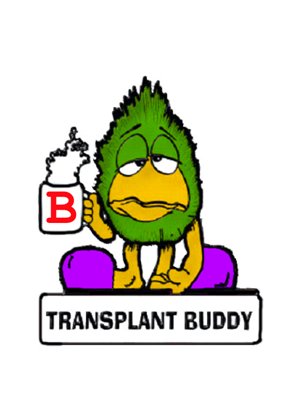Riti Bhatnagar presented to the Transplant Buddy group regarding Transplant Nutrition. With her knowledge of and experience with this subject, we could not have been in better hands. Thank you for sharing your time and knowledge Riti!! Below are some of the materials presented to the group.
Diet Guidelines:
1. Low Cholesterol, less Saturated Fats
2. Low Sodium (2-3 grams Sodium diet)
3. Low Sugar
4. More Calcium
Blood Cholesterol may be high due to the medications the patient now takes. High Cholesterol can increase the risk of heart disease.
Examples:
- Eat no more then 3-4 egg yolks per week.
- Select baked, broiled, or poached seafood, chicken or turkey.
- Eat less beef, lamb, pork and cheese.
- Avoid fatty meals such as cold cuts, sausage, bacon and liver.
- Choose skim or 1% Low fat milk.
- Avoid high fat gravy.
- Use spray or soft tub margarine instead of butter.
- Use small amounts of canola and olive oil.
Salt, fluid and some medications may cause the body to hold fluid. Too much fluid in the body can raise blood pressure.
- Avoid table salt.
- Avoid foods with visible salt (such as chips or saltine crackers)
- Eat less processed food (such as cold cuts, sausage, pickles, hot dogs, packaged food, cheese, rice mixes, and canned food).
Too much sugar in your blood is bad. Medications can raise the blood sugar. Eating fewer sweets helps to keep blood sugar normal. Eating fewer sweets can also help to control weight.
- Avoid candy, pastries and desserts.
- Choose fresh fruits instead of fresh juice. Juice is concentrated fruit and can be very high in sugar.
- Avoid sweetened drinks such as fruit juice, soda and other sweetened drinks.
- Drink more calorie–free beverages or water.
More Calcium:
Steroids can make bones weak. Eating more calcium can help to protect bones. Eat at least 3 servings of high calcium food per day.
- Milk and milk products.
- Juice with calcium added.
Recommended Foods:
- Lean meat, fish and poultry.
- Egg whites, nuts, and dry beans and peas, tofu.
- Skim /fat free or other Low-fat Dairy.
- Fruit (except grapefruits) and vegetables
- Whole grains
- Flavor foods with herbs and spices vs. salt
- Olive or canola oil or vegetable oil spreads
• Processed meats such as ham, bacon, sausage, corned beef, hot dogs, luncheon meat.
• Fried food/ meats.
• Canned beans, vegetables with salt, pickles/relish, olives or sauerkraut.
• Regular dairy
• Any seasoning made with salt and packaged foods made with salt, such as soups or condiments.
• High fat baked products, white bread, regular pasta and white rice
• Butter, shortening, partially hydrogenated oils, stick margarine, and lard.
• Beverages: Soft drinks, sport drinks, vegetable juices with salt, fruit drinks with sugar.
Exercise and Chronic Lung and Heart Disease The primary aim of exercise training is dependent on the individual’s goals. Common health and fitness benefits include:
• Increased muscle mass and/or tone
• Improvement in cardio-respiratory endurance
• Improvement in muscular strength and endurance
• Improvement in the immune system
• Reduction in risk of cardiovascular disease
• Reduction in risk of osteoporosis
• Increase in life expectancy
• Increased sense of well being
For the individual awaiting heart or lung transplantation, exercise training will improve functional capacity and help get through the surgery and onto the road to recovery optimally. Muscles that are “in shape” will allow you to get back on your feet after surgery.
The question is often asked, “Which is the best type of exercise?” The answer is fairly simple: Remember the goal is for exercise to be both safe and effective. So, pick an activity of the proper intensity and duration that you enjoy enough to perform regularly. Many activities in which we engage are stop-and-go in nature: yard work, gardening, housework, occupational activities, shopping, etc. Activities like bowling and golf, while recreational in nature, also fall into this category. While it is true that one can get fatigued from these types of activities, they are not a good choice for therapeutic exercise. You are encouraged to participate in all types of physical activity, but these low intensity stop-and-go activities should not be substituted for your regular exercise sessions of moderate to somewhat hard intensity.
The type of exercise that is most effective for most adults, especially those with chronic health issues, are activities such as walking, jogging, swimming, cycling, cross country skiing, in-line skating, stair stepping, aerobics classes, etc. These activities are aerobic in that they are continuous and the pace is one that is easily maintained for at least 20 to 30 minutes. One must choose the activities that are most appropriate, considering the level of exertion and the risk of injury that accompanies those activities. Sports we engage in as kids and young adults (football, basketball, soccer, tennis, etc.) are anaerobic. That is, they are stop-and-go in nature, but are of high intensity and therefore subject us to pushing our heart and muscles too hard.
Strength training with weights or Therabands can also be helpful in increasing metabolic rate (assisting with weight loss) in addition to strength.
A cardiopulmonary exercise test is the most accurate method of determining an exercise prescription. This is the amount of exercise that is both safe and effective for your needs. A target heart rate can then be determined according to that individual’s cardiopulmonary capacity and any drug side effects. An individual who undergoes heart transplantation will not have a target heart rate prescription because of the blunted heart rate response after transplant.
* Whether or not it is appropriate for you to exercise as you await transplantation should be determined by your physician.
Aerobic Exercise Prescription
Warm-up: _______________ for 3-5 minutes at an easy pace – one at which you feel you could go on indefinitely. (RPE of 1-2)
Conditioning: _______________ for _______ minutes. Exercise at a level which you consider to be moderate to somewhat hard (RPE of 3-4); healthier, more motivated individuals may even push to a level of hard (RPE of 5). It is reasonable to expect some shortness of breath, muscle fatigue, and even perspiration. Your target heart rate has been established as a range of _______ to _______ beats per minute. You may increase your duration by ____ min.(s) every ____ session(s) until you reach a goal of _______ min.(s)
Cool-down: _______________ at a very easy pace for 3-5 minutes before stopping.
The frequency of exercise needs to be a minimum of 3 times a week to be effective. A goal of 5-6 times a week is even more productive.
Fortunately, it’s not necessary to check your heart rate every time you exercise. Once you have experienced exercise at your target heart rate range, you can rely on your feelings of perceived exertion to determine exercise intensity. Simply ask the question, “How hard am I working?” on a scale of 1-10. Heart transplant patients will use this method to adhere to an exercise intensity that is appropriate.
Rating of Perceived Exertion (RPE)
0 Nothing at all (Resting)
0.5 Very, very easy
1 Very easy
2 Easy
3 Moderate
4 Somewhat hard
5 Hard
6
7 Very hard
8
9
10 Very, very hard
Maximal
• Increased muscle mass and/or tone
• Improvement in cardio-respiratory endurance
• Improvement in muscular strength and endurance
• Improvement in the immune system
• Reduction in risk of cardiovascular disease
• Reduction in risk of osteoporosis
• Increase in life expectancy
• Increased sense of well being
For the individual awaiting heart or lung transplantation, exercise training will improve functional capacity and help get through the surgery and onto the road to recovery optimally. Muscles that are “in shape” will allow you to get back on your feet after surgery.
The question is often asked, “Which is the best type of exercise?” The answer is fairly simple: Remember the goal is for exercise to be both safe and effective. So, pick an activity of the proper intensity and duration that you enjoy enough to perform regularly. Many activities in which we engage are stop-and-go in nature: yard work, gardening, housework, occupational activities, shopping, etc. Activities like bowling and golf, while recreational in nature, also fall into this category. While it is true that one can get fatigued from these types of activities, they are not a good choice for therapeutic exercise. You are encouraged to participate in all types of physical activity, but these low intensity stop-and-go activities should not be substituted for your regular exercise sessions of moderate to somewhat hard intensity.
The type of exercise that is most effective for most adults, especially those with chronic health issues, are activities such as walking, jogging, swimming, cycling, cross country skiing, in-line skating, stair stepping, aerobics classes, etc. These activities are aerobic in that they are continuous and the pace is one that is easily maintained for at least 20 to 30 minutes. One must choose the activities that are most appropriate, considering the level of exertion and the risk of injury that accompanies those activities. Sports we engage in as kids and young adults (football, basketball, soccer, tennis, etc.) are anaerobic. That is, they are stop-and-go in nature, but are of high intensity and therefore subject us to pushing our heart and muscles too hard.
Strength training with weights or Therabands can also be helpful in increasing metabolic rate (assisting with weight loss) in addition to strength.
A cardiopulmonary exercise test is the most accurate method of determining an exercise prescription. This is the amount of exercise that is both safe and effective for your needs. A target heart rate can then be determined according to that individual’s cardiopulmonary capacity and any drug side effects. An individual who undergoes heart transplantation will not have a target heart rate prescription because of the blunted heart rate response after transplant.
* Whether or not it is appropriate for you to exercise as you await transplantation should be determined by your physician.
Aerobic Exercise Prescription
Warm-up: _______________ for 3-5 minutes at an easy pace – one at which you feel you could go on indefinitely. (RPE of 1-2)
Conditioning: _______________ for _______ minutes. Exercise at a level which you consider to be moderate to somewhat hard (RPE of 3-4); healthier, more motivated individuals may even push to a level of hard (RPE of 5). It is reasonable to expect some shortness of breath, muscle fatigue, and even perspiration. Your target heart rate has been established as a range of _______ to _______ beats per minute. You may increase your duration by ____ min.(s) every ____ session(s) until you reach a goal of _______ min.(s)
Cool-down: _______________ at a very easy pace for 3-5 minutes before stopping.
The frequency of exercise needs to be a minimum of 3 times a week to be effective. A goal of 5-6 times a week is even more productive.
Fortunately, it’s not necessary to check your heart rate every time you exercise. Once you have experienced exercise at your target heart rate range, you can rely on your feelings of perceived exertion to determine exercise intensity. Simply ask the question, “How hard am I working?” on a scale of 1-10. Heart transplant patients will use this method to adhere to an exercise intensity that is appropriate.
Rating of Perceived Exertion (RPE)
0 Nothing at all (Resting)
0.5 Very, very easy
1 Very easy
2 Easy
3 Moderate
4 Somewhat hard
5 Hard
6
7 Very hard
8
9
10 Very, very hard
Maximal



No comments:
Post a Comment